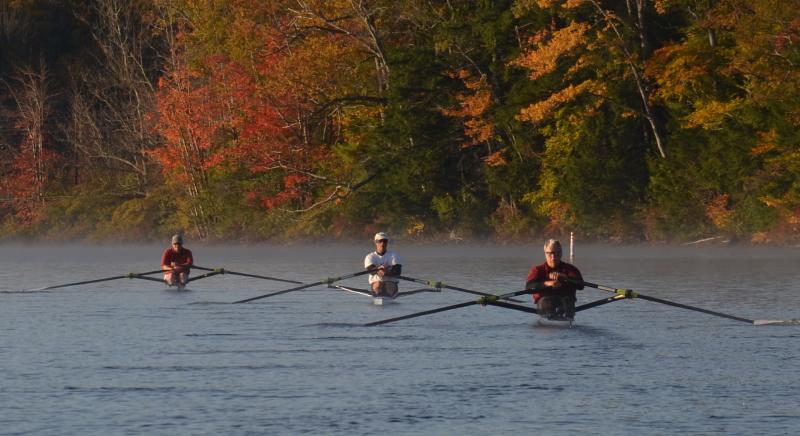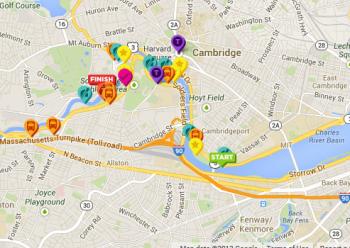A long, steady stay: Training for the Head of the Charles on Megunticook Lake
CAMDEN — Three shells slice through the predawn mist on Megunticook Lake, moving like arrows up alongside Fernald's Neck toward Bog Bridge. While each deep in their own solitude, the three rowers communicate with slight signals, not a word spoken. There is no need; they've been training together for almost a year, and now it is time to drive to Boston to compete in the Head of the Charles Regatta, the world renowned rowing competition.
These guys are not young bucks; they are, however, long-time athletes and rowers and their strength is refined and purposeful. On Friday, Oct. 18, Don Seales, of Searsmont; Jeff Folz, of Camden; and Jim Wescott, of Belfast, will strap their long shells to the tops of their respective cars and small pickups and caravan to Cambridge where they will join 9,000 competitors to swiftly navigate the Charles River.
The three are racing individually, but have been training together since last November when they learned they had been accepted as participants in the regatta. Not only is the Head of the Charles the largest rowing race in the world and a highly-competitive event, it is equally difficult to be admitted to it.
‘Rowing a race is an art, not a frantic scramble. It must be rowed with head power as well as hand power. From the first stroke all thoughts of the other boats must be blocked out. Your thoughts must be directed to you and your boat, always positive, never negative. — George Yeomans Pocock.
The three Midcoast Maine men applied last year and were surprised to learn they were in.
“I think we did something bad in our prior lives,” they joked, at 7:30 a.m. on a Sunday morning, hauling sweatshirts over their heads after an eight-mile row up and down Megunticook Lake.
The Head of the Charles Regatta has been an annual event since 1965, and draws more than 300,000 spectators to the banks of the river to watch the boats make the three-mile course.
The Cambridge Boat Club hosts the event and pulls it off with the help of 1,400 volunteers. Monitoring the heavy-trafficked Charles is intricate, with individual and teams of rowers spacing out starts in 15-second intervals through the “funnel.” The course begins at the Boston University Boathouse and almost immediately runs under the combination of a railroad trestle bridge and the Boston University Bridge. Then it is an congested upstream race through specified race lanes. Screw up those lanes and racers will incur 60-second penalties, in addition to buoy violation penalties.
“The most common sports in America offer only a first or second place,” said Folz. “First is glorified beyond reasonable proportions and second is losing. Kids’ soccer matches don’t keep score and everyone gets a trophy in order to mitigate the stigma of losing. Elevate the glory of participation and personal goal setting and losing becomes an unnecessary concern. There are some events like the Boston Marathon, the American Birkebeiner, the largest cross-coutnry ski race in North America, and the Head of the Charles where first is wonderful, but participating is the universal reward, competing hard and achieving your own goal are the trophies.”
The Head of the Charles will be a far cry from the wide waters of Megunticook Lake, but the three racers are savvy. Jim Wescott rowed the regatta in 1982, 1983, 1984 and 1986, in both single and double shells.
He also coached the Colby College track and field program for 25 years, where he rewrote 28 of 32 records. He designed the training regimen for the three rowers.
“He scientifically master-minded our training,” said Folz.
Wescott sets the goals. One of them: “Move the shell with as little energy possible at the fastest speed that is maintainable,” said Seales.
“It always helps to have a coach from Colby,” he said. “Having training partners allows us to push each other.”
He lifted off his glasses, which are equipped with a little side mirror.
The regatta will be a “cerebral synaptic overload,” they agree, an exercise in concentration as they synchronize steering, speed and vision, all the while going backward up a river.
“The water is moving with all these other people,” said Wescott.
“If I hold you off to Eliot Street, I’m doing good,” said Seales, to Wescott.
Each of them will be highly intent on monitoring their own pace, setting strokes per minute.
“By the middle of the race, I’ll be forcing those marks,” said Wescott.
The daily training, said Seales, is a necessary ritual that is healthy, and slows the aging process.
“Rowing is an endurance exercise that burns the maximum number of calories to offset my eating habits to control my weight,” he said. “My rowing partners, Jim and Jeff, keep me honest and give me incentive to train hard. We depend on each other a great deal to push the training along at a productive rate, but also use each other as a yard stick to measure improvements. We coach each other and help make rigging changes to gain the optimum speed potential we have.”
Folz said: “If I had to use one word to describe morning training on Megunticook, the word would be fun. I know that for an hour and a half a day, I’m going to do something I love to do with good friends who also love the sport and we’re going to do it on one of the most beautiful, pure lakes in the country. I enjoy “sleeping in” as much as the next person, but the rewards of a good workout, the exhilaration, getting to chow down on a big breakfast, feeling alert and in tune well into the afternoon, offset the few ugly seconds it takes to slide out from under the covers while it’s still dark out.”
Both Seales and Folz are rowing 2013 Fluidesign elite rowing shells produced by the Ontario-based Fluidesign Company.
“This is the best one of eight rowing shells I row and is the lightest at 30.4 pounds,” said Seales.
It is constructed from carbon fiber and Seales’ fastest recorded speed is 5.3 meters per second.
It is also stiff, which, according to Folz, keeps the energy of the stroke from being absorbed by boat flex.
“All of us can cover a quarter mile in well under two minutes and 10 miles in an hour and 15 to an hour and 25 minutes, depending on wind conditions,” said Folz. “Race pace — the ideal race pace is the consistent speed a rower can generate over a given race distance so that the stroke that puts you across the finish line is absolutely the last stroke you’re capable of making. Over a long period of training, you can become very adept at discovering, improving and maximizing your pace sense and capabilities. A speed that feels comfortable in the first quarter of a race may be impossible to maintain in the last quarter — fly and die = slow.”
“My race pace is a sustainable 3.6 miles per second,” said Seales. “The Head of the Charles race pace target for me is 3.75 miles per second.”
Seales sees the Head the Charles as a chance to test mental and physical limits or concentration abilities against the best rowers in his age group.
There is much more skill needed than just being a good sculler,” he said. “Concentration levels required exceed abilities to focus on just going fast and steering a best line course. Weather, limited space under bridges, winding river turns, orange and green course/penalty buoys, race officials watching every move, large numbers of spectators yelling are just some of the distractions. The Head of the Charles is the test for finding those limits. The results are sometimes a matter of good/bad luck, as well.”
Folz said he appreciated showing up at each morning training session, “to inspire friends and have them motivate me, so we can each reach our goal at the largest event in our sport has already cast my trophy. I’m prepared to row my best performance in years and that’s a great feeling.”
Rowing on Megunticook is a growing phenomenon. The nonprofit Megunticook Rowing, has been formed, and organizes various programs for different age groups, from high school to seniors. The 20th annual Megunticook Regatta was held Sept. 8.
Camden Hills Regional High School’s rowing teams practice on the lake through the week. They are rowing on former Radcliffe shells that were donated to the program.
Editorial Director Lynda Clancy can be reached at lyndaclancy@penbaypilot.com; 706-6657.



































